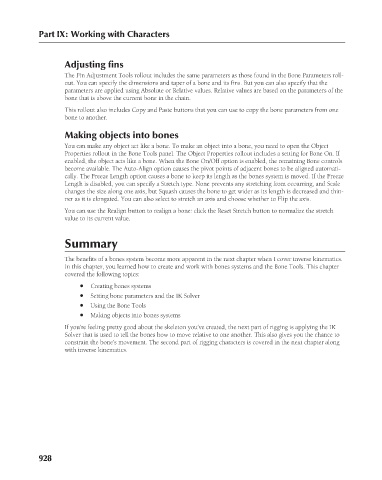Page 976 - Kitab3DsMax
P. 976
Part IX: Working with Characters
Adjusting fins
The Fin Adjustment Tools rollout includes the same parameters as those found in the Bone Parameters roll-
out. You can specify the dimensions and taper of a bone and its fins. But you can also specify that the
parameters are applied using Absolute or Relative values. Relative values are based on the parameters of the
bone that is above the current bone in the chain.
This rollout also includes Copy and Paste buttons that you can use to copy the bone parameters from one
bone to another.
Making objects into bones
You can make any object act like a bone. To make an object into a bone, you need to open the Object
Properties rollout in the Bone Tools panel. The Object Properties rollout includes a setting for Bone On. If
enabled, the object acts like a bone. When the Bone On/Off option is enabled, the remaining Bone controls
become available. The Auto-Align option causes the pivot points of adjacent bones to be aligned automati-
cally. The Freeze Length option causes a bone to keep its length as the bones system is moved. If the Freeze
Length is disabled, you can specify a Stretch type. None prevents any stretching from occurring, and Scale
changes the size along one axis, but Squash causes the bone to get wider as its length is decreased and thin-
ner as it is elongated. You can also select to stretch an axis and choose whether to Flip the axis.
You can use the Realign button to realign a bone: click the Reset Stretch button to normalize the stretch
value to its current value.
Summary
The benefits of a bones system become more apparent in the next chapter when I cover inverse kinematics.
In this chapter, you learned how to create and work with bones systems and the Bone Tools. This chapter
covered the following topics:
l Creating bones systems
l Setting bone parameters and the IK Solver
l Using the Bone Tools
l Making objects into bones systems
If you’re feeling pretty good about the skeleton you’ve created, the next part of rigging is applying the IK
Solver that is used to tell the bones how to move relative to one another. This also gives you the chance to
constrain the bone’s movement. The second part of rigging characters is covered in the next chapter along
with inverse kinematics.
928

